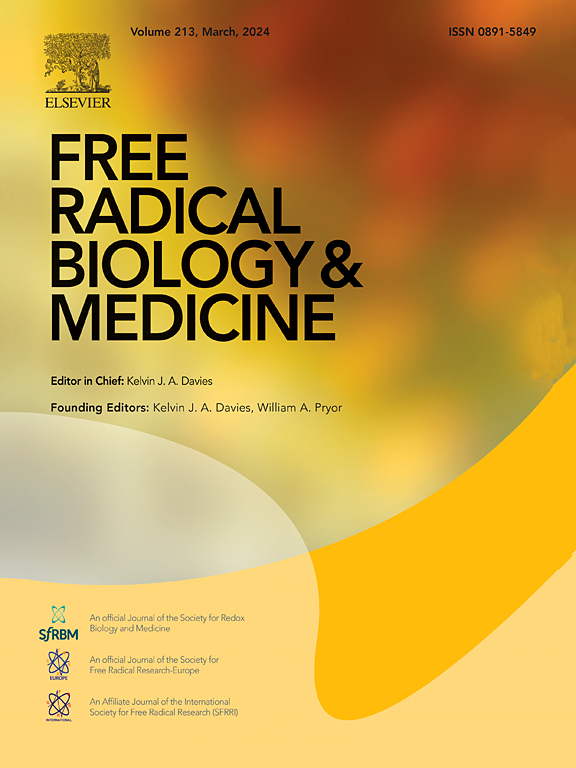Altered mitochondrial unfolded protein response and protein quality control promote oxidative distress in down syndrome brain
IF 7.1
2区 生物学
Q1 BIOCHEMISTRY & MOLECULAR BIOLOGY
引用次数: 0
Abstract
Down Syndrome (DS) is a genetic disorder caused by the presence of an extra copy of chromosome 21, and leading to various developmental and cognitive defects. A critical feature of DS is the occurrence of oxidative distress particularly in the brain, which exacerbates neurodevelopmental processes. Mitochondria play a crucial role in cell energy metabolism and their impairment is one of the major causes of oxidative distress in several pathologies. Hence, this study investigates mitochondrial proteostasis by the mean of the mitochondrial Unfolded Protein Response (UPRmt) and the mitochondrial protein quality control (MQC) mechanisms in the context of DS, focusing on their implications in redox homeostasis in brain development. We analyzed key UPRmt markers and mitochondrial function in the frontal cortex isolated fromTs2Cje mice, a model for DS, across different developmental stages. Our results demonstrate significant alterations in UPRmt markers, particularly at postnatal day 0 (P0) and 1 month (1M). These changes indicate early UPRmt activation, primarily driven by the ATF5/GRP75 axis, although compromised by reduced levels of other components. Impaired UPRmt correlates with decreased mitochondrial activity, evidenced by reduced oxygen consumption rates and altered expression of OXPHOS complexes. Additionally, elevated oxidative stress markers such as 3-nitrotyrosine (3-NT), 4-hydroxynonenal (HNE), and protein carbonyls (PC) were observed, linking mitochondrial dysfunction to increased oxidative damage. Defects of MQC, including disrupted biogenesis, increased fission, and the activation of mitophagy were evident mostly at P0 and 1M consistent with UPRmt activation.
Principal Component Analysis revealed distinct phenotypic differences between Ts2Cje and control mice, driven by these molecular alterations. Our findings underscore the critical role of UPRmt and MQC in DS brain development, highlighting potential therapeutic targets to mitigate mitochondrial dysfunction and oxidative distress, thereby alleviating some of the neurodevelopmental and cognitive impairments associated with DS.

线粒体折叠蛋白反应和蛋白质量控制的改变促进了唐氏综合征大脑的氧化损伤。
唐氏综合征(Down Syndrome,DS)是一种遗传性疾病,由 21 号染色体多出一条拷贝引起,会导致各种发育和认知缺陷。唐氏综合症的一个重要特征是发生氧化障碍,尤其是在大脑中,这加剧了神经发育过程。线粒体在细胞能量代谢中起着至关重要的作用,而线粒体功能受损是多种病症中氧化损伤的主要原因之一。因此,本研究通过线粒体折叠蛋白反应(UPRmt)和线粒体蛋白质量控制(MQC)机制研究了DS背景下的线粒体蛋白稳态,重点关注它们在大脑发育过程中氧化还原稳态的影响。我们分析了从Ts2Cje小鼠(一种DS模型)分离出来的额叶皮层在不同发育阶段的关键UPRmt标记物和线粒体功能。我们的研究结果表明,UPRmt 标记发生了重大变化,尤其是在出生后第 0 天(P0)和 1 个月(1M)。这些变化表明,UPRmt 的早期激活主要由 ATF5/GRP75 轴驱动,但也受到其他成分水平降低的影响。受损的 UPRmt 与线粒体活性的降低有关,耗氧率的降低和 OXPHOS 复合物表达的改变证明了这一点。此外,还观察到 3-硝基酪氨酸(3-NT)、4-羟基壬烯醛(HNE)和蛋白质羰基(PC)等氧化应激标记物升高,这将线粒体功能障碍与氧化损伤增加联系起来。线粒体质量控制(MQC)缺陷,包括生物生成中断、裂变增加和有丝分裂吞噬激活,主要在 P0 和 1M 时明显,这与 UPRmt 激活一致。主成分分析显示,在这些分子改变的驱动下,Ts2Cje 和对照小鼠之间存在明显的表型差异。我们的研究结果强调了 UPRmt 和 MQC 在 DS 大脑发育中的关键作用,突出了缓解线粒体功能障碍和氧化损伤的潜在治疗靶点,从而减轻了与 DS 相关的一些神经发育和认知障碍。
本文章由计算机程序翻译,如有差异,请以英文原文为准。
求助全文
约1分钟内获得全文
求助全文
来源期刊

Free Radical Biology and Medicine
医学-内分泌学与代谢
CiteScore
14.00
自引率
4.10%
发文量
850
审稿时长
22 days
期刊介绍:
Free Radical Biology and Medicine is a leading journal in the field of redox biology, which is the study of the role of reactive oxygen species (ROS) and other oxidizing agents in biological systems. The journal serves as a premier forum for publishing innovative and groundbreaking research that explores the redox biology of health and disease, covering a wide range of topics and disciplines. Free Radical Biology and Medicine also commissions Special Issues that highlight recent advances in both basic and clinical research, with a particular emphasis on the mechanisms underlying altered metabolism and redox signaling. These Special Issues aim to provide a focused platform for the latest research in the field, fostering collaboration and knowledge exchange among researchers and clinicians.
 求助内容:
求助内容: 应助结果提醒方式:
应助结果提醒方式:


